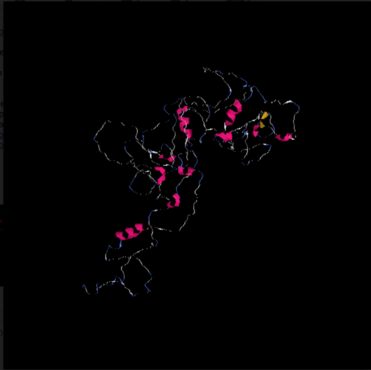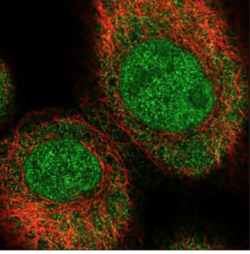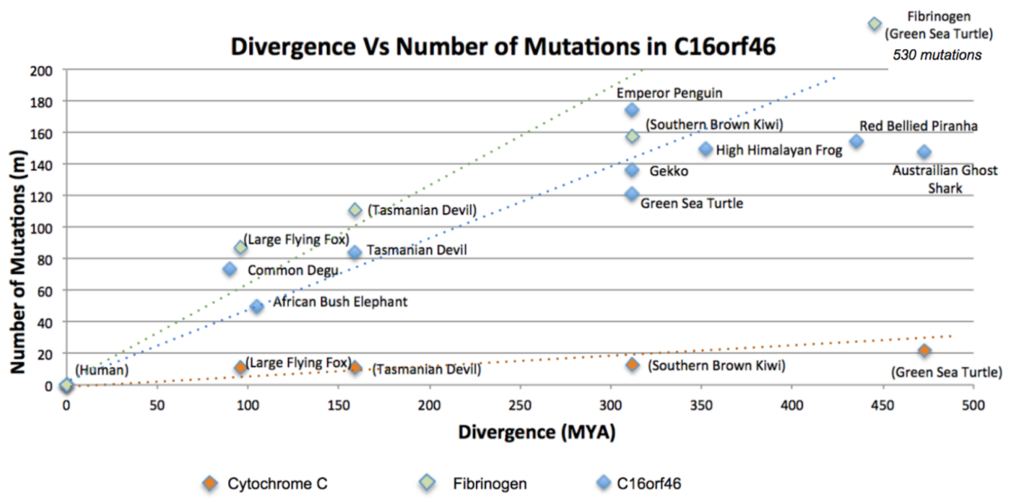Biology:C16orf46
 Generic protein structure example |

Chromosome 16 open reading frame 46 is a protein of yet to be determined function in Homo sapiens. It is encoded by the C16orf46 gene with NCBI accession number of NM_001100873. It is a protein-coding gene with an overlapping locus.[2]
Gene
An alternative name for this gene is FLJ32702, however it is most commonly referred to as C16orf46.[3]
Location
The C16orf26 gene is found on chromosome 16q23.2 negative strand.[4] The promoter region is 1152 base pairs long.[5] It has three exons, one from 1-380 bp, the second from 381 to 1254 bp, and the third from 1255 to 1982 bp.[2]
Expression
C16orf46 is broadly expressed in the testis and thyroid as well as 18 other tissues.[4] These tissue expression patterns are found to be low to moderate (25-50%).[6] When looking at tissue profiles, the highest expression is in the adult mammalian kidney, liver, prefrontal cortex, cerebellum, heart, and brain.[7]
Protein
Protein Analysis
The full C16orf46 protein is 417 amino acids long.[9] It has no isoforms, and its most distant ortholog, Rhincodon typus (whale shark), also has no known isoforms.[10] The molecular weight was found to be 45.8 kdal.[11] The isoelectric point is 7.4, average for all proteins, and C16orf46 is electrically neutral.[12]
C16orf46 is predicted to be found in the nucleus by all orthologs.[13]
The secondary structure of C16orf46 has alternating alpha helices and beta sheets.[14]
Protein Level Regulation
In C16orf46, there is N-linked glycosylation, O-linked glycosylation, and SUMOylation.[15][16]
There are phosphorylation sites found with the kinases CKII, CKI, PKC, and cdc2.[17]
A coronavirus cleavage site is predicted at the 235 amino acid position.[18] There are also tyrosine motif locations between amino acids 42-45 and 251–252.[19]
Transcript Level Regulation
mRNA folding on the 5' UTR predicts a stem loop twice in the area between base pairs 47–90.[20]
Homologs
Orthologs
C16orf46 has over 50 orthologs ranging from primate to chordate.[21] The table below shows a representation of the diversity of C16orf46 by listing a selection of orthologs found using NCBI. When C16orf46 Homo sapiens was run through a multiple alignment sequence program, Clustal Omega, against 20 true orthologs and 16 distant orthologs, Trp74 and Pro212 were found to be conserved in all.[22]
| Species | Common Name | Divergence (MYA) | Accession Number | Identity |
|---|---|---|---|---|
| Homo sapiens | Humans | --- | XP_016878405.1 | 100.0% |
| Ochotona princeps | American Pika | 90 | XP_004584265.1 | 52.7% |
| Octodon degus | Common Degu | 90 | XP_003434773.2 | 47.8% |
| Ursus maritimus | Polar Bear | 96 | XP_008687958.1 | 67.5% |
| Leptonychotes weddellii | Weddell Seal | 96 | XP_006748170.1 | 67.2% |
| Canis lupus | Gray Wolf | 96 | XP_003434773.2 | 65.8% |
| Pteropus vampyrus | Large Flying Fox | 96 | XP_011354946.1 | 63.5% |
| Sus scrofa | Wild Boar | 96 | XP_020952705.1 | 61.5% |
| Bos indicus | Zebu | 96 | XP_019835282.1 | 60.2% |
| Erinaceus europaeus | European Hedgehog | 96 | XP_007516703.1 | 56.7% |
| Loxodonta africana | African Bush Elephant | 105 | XP_010596137.1 | 60.9% |
| Sarcophilus harrisii | Tasmanian Devil | 159 | XP_003757901.1 | 43.1% |
| Apteryx australis | Southern Brown Kiwi | 312 | XP_013796688.1 | 18.5% |
| Aptenodytes forsteri | Emperor Penguin | 312 | XP_019327074.1 | 17.4% |
| Chelonia mydas | Green Sea Turtle | 312 | XP_007059324.1 | 29.7% |
| Gekko japonicus | Gekko Japonicus | 312 | XP_015261305.1 | 25.3% |
| Nanorana parkeri | High Himalaya Frog | 352 | XP_018410908.1 | 22.4% |
| Pygocentrus nattereri | Red Bellied Piranha | 435 | XP_017578196.1 | 21.2% |
| Lepisosteus oculatus | Spotted Gar | 435 | XP_015223705.1 | 20.6% |
| Callorhinchus milii | Australian Ghost Shark | 473 | XP_007887408.1 | 22.7% |
Paralogs
C16orf46 has no known paralogs.[21]
Mutations
C16orf46 has been compared against Fibrinogen, a protein which mutates rapidly, and Cytochrome C, a protein which mutates slowly.
As can be seen below, when multiple species of the three proteins were plotted, C16orf46 more closely resembled that of Fibrinogen than Cytochrome C, suggesting a possible rapid mutation.[21]
Interacting Proteins
C16orf46 interacts with FAT3 which has been linked to neurite interactions during development.[23] C16orf46 is thought to have coexpression with the PLAC8L1 and CFAP43 gene, both of unknown function.[24]
Clinical Significance
There are higher levels of C16orf46 expression in pancreatic adenocarcinoma tumor epithelia tissue compared to the control.[25] There is also higher gene expression in patients with small-cell carcinoma compared to the control.[26]
References
- ↑ "I-TASSER results". https://zhanglab.ccmb.med.umich.edu/I-TASSER/output/S395210/.[yes|permanent dead link|dead link}}]
- ↑ 2.0 2.1 "Gene: C16orf46 (OTTHUMG00000137629) - Summary - Homo sapiens - Vega Genome Browser 68" (in en-gb). http://vega.archive.ensembl.org/Homo_sapiens/Gene/Summary?g=OTTHUMG00000137629;r=16:8105349.
- ↑ Database, GeneCards Human Gene. "C16orf46 Gene - GeneCards | CP046 Protein | CP046 Antibody". https://www.genecards.org/cgi-bin/carddisp.pl?gene=C16orf46.
- ↑ 4.0 4.1 "C16orf46 Symbol Report | HUGO Gene Nomenclature Committee". https://www.genenames.org/cgi-bin/gene_symbol_report?hgnc_id=HGNC:26525.
- ↑ "Genomatix - NGS Data Analysis & Personalized Medicine". https://www.genomatix.de/.
- ↑ geo. "Home - GEO - NCBI" (in en). https://www.ncbi.nlm.nih.gov/geo/.
- ↑ "Gene: C16orf46 - ENSG00000166455" (in en). https://bgee.org/?page=gene&gene_id=ENSG00000166455.
- ↑ "Anti-C16orf46 antibody produced in rabbit HPA041136". https://www.sigmaaldrich.com/catalog/product/sigma/hpa041136?lang=en®ion=US.
- ↑ "uncharacterized protein C16orf46 isoform X1 [Homo sapiens - Protein - NCBI"]. https://www.ncbi.nlm.nih.gov/protein/XP_016878406.1.
- ↑ "uncharacterized protein C16orf46 homolog [Rhincodon typus - Protein - NCBI"]. https://www.ncbi.nlm.nih.gov/protein/1160128351.
- ↑ Kozlowski, Lukasz P.. "CALCULATION OF PROTEIN ISOELECTRIC POINT" (in en). http://isoelectric.org/calculate.php.
- ↑ EMBL-EBI. "SAPS < Sequence Statistics < EMBL-EBI" (in en). https://www.ebi.ac.uk/Tools/seqstats/saps/.
- ↑ "PSORT WWW Server". https://psort.hgc.jp/.
- ↑ "Bioinformatics Toolkit". https://toolkit.tuebingen.mpg.de/#/jobs/3627327.
- ↑ "NetNGlyc 1.0 Server" (in en). http://www.cbs.dtu.dk/services/NetNGlyc/.
- ↑ "NetOGlyc 4.0 Server" (in en). http://www.cbs.dtu.dk/services/NetOGlyc/.
- ↑ "NetPhos 3.1 Server" (in en). http://www.cbs.dtu.dk/services/NetPhos/.
- ↑ "NetCorona 1.0 Server" (in en). http://www.cbs.dtu.dk/services/NetCorona/.
- ↑ "Human Protein Reference Database". http://www.hprd.org/.
- ↑ "The Mfold Web Server | mfold.rit.albany.edu" (in en). http://unafold.rna.albany.edu/?q=mfold.
- ↑ 21.0 21.1 21.2 "BLAST: Basic Local Alignment Search Tool". https://blast.ncbi.nlm.nih.gov/Blast.cgi.
- ↑ EMBL-EBI. "Clustal Omega < Multiple Sequence Alignment < EMBL-EBI" (in en). https://www.ebi.ac.uk/Tools/msa/clustalo/.
- ↑ Lab, Mike Tyers. "BioGRID | Database of Protein, Chemical, and Genetic Interactions" (in en). https://thebiogrid.org/.
- ↑ "C16orf46 protein (human) - STRING interaction network" (in en). https://string-db.org/cgi/network.pl?taskId=Tsisxb0h6voQ.
- ↑ "GDS4103 / 230281_at". https://www.ncbi.nlm.nih.gov/geo/tools/profileGraph.cgi?ID=GDS4103:230281_at.
- ↑ "GDS4794 / 230281_at". https://www.ncbi.nlm.nih.gov/geo/tools/profileGraph.cgi?ID=GDS4794:230281_at.
 |



